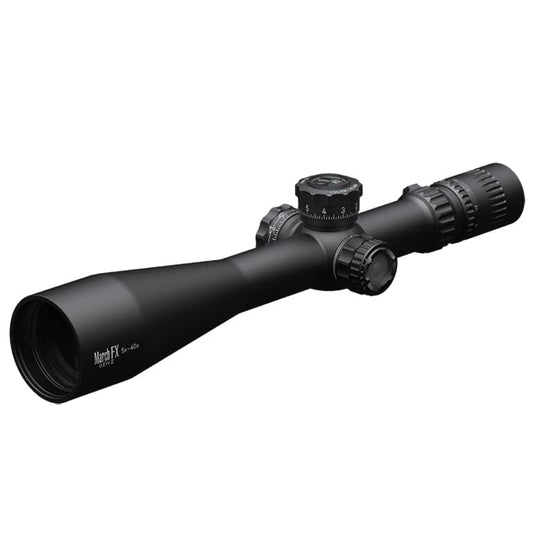

The March FX Tactical Gen II 5-40x56mm FMA-1 Reticle Riflescope offers a precise first focal plane design, allowing the reticle to adjust in size relative to the target as you zoom. This feature enhances accuracy at varying distances, ideal for competitive precision shooting. Built with extra-low dispersion glass, the scope provides high clarity and detail, making it effective in low-light conditions. The illuminated reticle offers six brightness levels, ensuring visibility in diverse lighting environments.
Lockable turrets enable quick and accurate adjustments, while the fast focus eyepiece allows for swift target acquisition. With a side focus parallax adjustment from 10 yards to infinity, you can maintain sharp focus at all distances. The durable construction ensures it withstands harsh conditions, making it a reliable choice for tactical shooting and hunting enthusiasts.
Features:
- FIRST FOCAL PLANE RETICLE for consistent scaling at any magnification, enhancing target acquisition.
- EXTRA LOW DISPERSION GLASS minimizes color fringing and distortion, providing exceptional clarity.
- ILLUMINATED RETICLE with six brightness levels for enhanced visibility in varying light conditions.
- LOCKABLE TURrets ensure settings remain stable during use, preventing accidental adjustments.
- FAST FOCUS EYEPIECE allows quick adjustments for a sharp sight picture, ideal for fast-paced shooting scenarios.
- PARALLAX ADJUSTMENT from 10 yards to infinity for precise focusing at any distance, ensuring accuracy.
- DURABLE CONSTRUCTION designed to withstand recoil and harsh conditions, making it suitable for tactical use.
- LIGHTWEIGHT DESIGN enhances portability without compromising on functionality, perfect for extended use.
Technical Specifications
| Specification | Details |
|---|---|
| Magnification | 5x - 40x |
| Objective Lens Diameter | 56mm |
| Tube Diameter | 34mm |
| Reticle | FMA-1 |
| Weight | 31.39 ounces |
| Length | 15.24 inches |
| Elevation Adjustment | 76 MOA |
| Windage Adjustment | 38 MOA |
What's in the Box?
- Flip caps
- Sunshade
- Lens cloth
- Fast lever
- MD disk
Customer Reviews
"Absolutely love this scope! The clarity is unmatched, even in low light." - Alex R.
"Easy to set up and the reticle is perfect for my long-range shooting." - Jamie T.
FAQ
How does the first focal plane reticle work? The first focal plane reticle changes size as you adjust the magnification. This allows you to use holdovers at any magnification level, maintaining accuracy and consistency.
Is the scope suitable for low-light conditions? Yes, the FX Tactical Gen II features extra low dispersion glass and an illuminated reticle, making it effective in low-light environments.
What is the parallax adjustment range? The parallax adjustment ranges from 10 yards to infinity, allowing for precise focusing based on shooting distance.
How durable is this scope? The scope is built to withstand harsh conditions, featuring a robust design that is both shockproof and waterproof.
Can I use this scope for competitive shooting? Absolutely, the features such as the lockable turrets and fast focus eyepiece make it ideal for competitive environments.
Similar Models
Looking for more options? Explore our complete selection of March optics, including the March 1-8x24mm for versatile magnification and the March 3-24x52mm for enhanced targeting at longer distances. Our collection offers a variety of high-performance riflescopes tailored to your shooting needs.
You May Also Like
Here’s some of our most similar products people are buying. Click to discover trending style.







